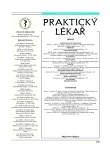Microdialysis of adipose tissue and its application in clinical research and practice
Authors:
J. Křemen 1; K. Anderlová 1; J. Bláha 2; Š. Svačina 1; M. Haluzík 1
Authors‘ workplace:
III. interní klinika 1. LF UK a VFN, Praha
přednosta prof. MUDr. Š. Svačina, DrSc.
1; Klinika anesteziologie, resuscitace a intenzivní medicíny 1. LF UK
a VFN, Praha, přednosta MUDr. M. Stříteský, CSc.
2
Published in:
Prakt. Lék. 2005; 85(8): 434-436
Category:
Various Specialization
Overview
Microdialysis is a minimally invasive technique allowing continuous monitoring of the composition of extracellular fluid and local changes of tissue metabolism in vivo (concentration of glucose, glycerol, lactate, pyruvate, glutamate, urea, catecholamines, aminoacids, etc.). The microdialysis unit is a biluminal probe which is perfused at a constant rate with microdialysis solution (perfusate). This solution is separated from interstitial space by a semipermeable membrane. Substances diffuse through the membrane in the direction of the concentration gradient. Therefore, the composition of the solution acquired (dialysate) reflects the composition of the extracellular fluid. It is important to note that numerous factors can affect the composition of dialysate such as: length of membrane, blood flow, perfusion rate. At present, microdialysis has not only experimental but also clinical applications in different groups of patients (patients with nutrition disorders, endocrine disease, critically ill patients, patients after transplantation and reconstruction surgery).
Key words:
microdialysis – interstitial fluid – local metabolism.
Labels
General practitioner for children and adolescents General practitioner for adultsArticle was published in
General Practitioner

2005 Issue 8
Most read in this issue
- Bacterial immunomodulators
- Antibiotics and their application in pregnancy
- Diagnosis and therapy of tracheal stenosis
- Type A aortic dissection, case reports
